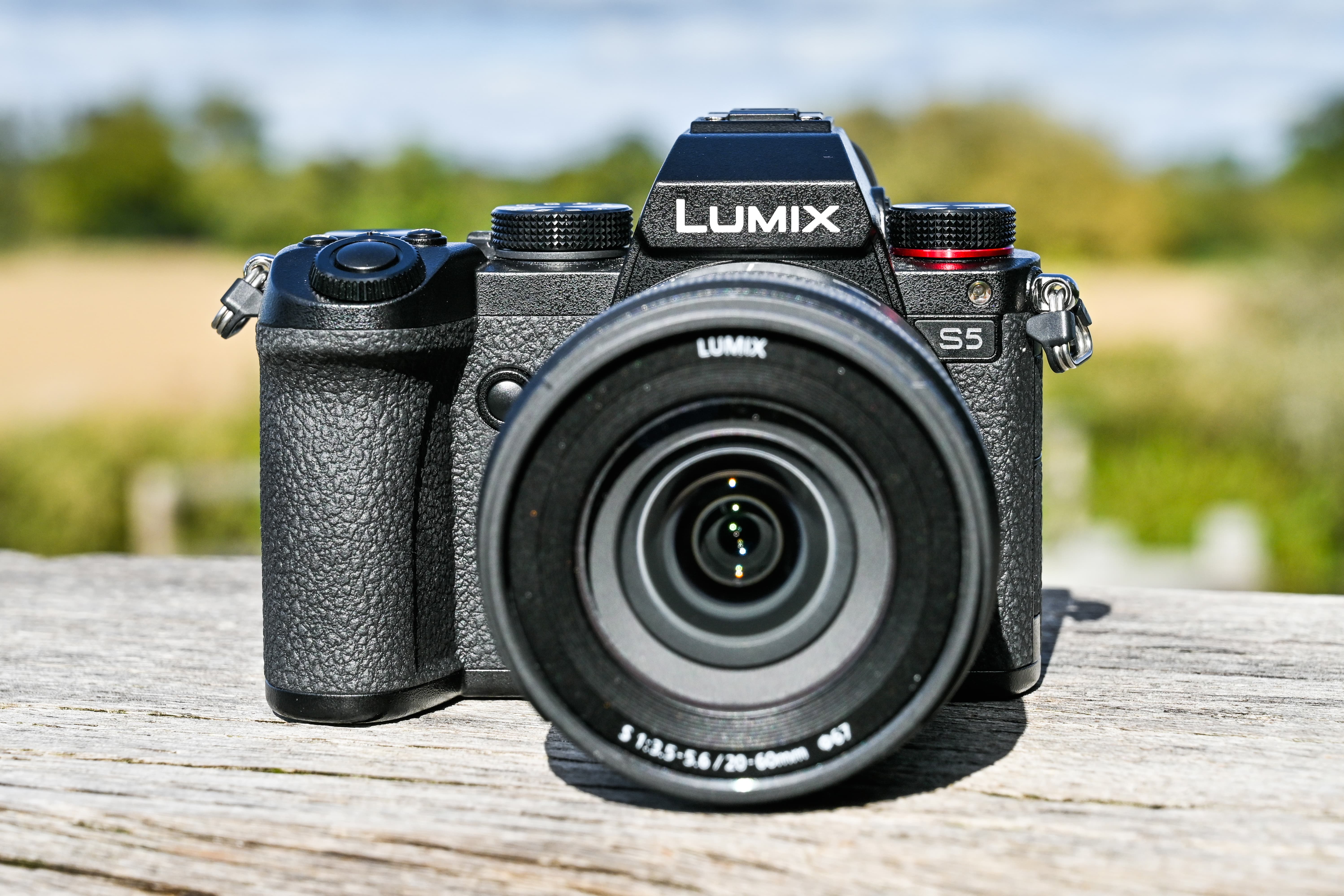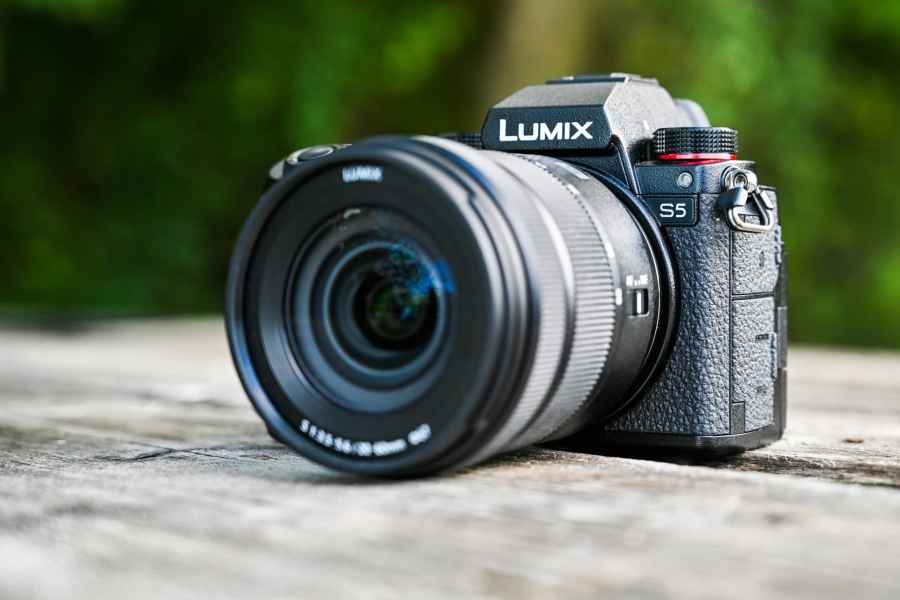Panasonic Lumix S5 at a glance:
- £1799 body only (£1999 with 20-60mm kit lens)
- 24.2MP full-frame CMOS sensor
- 5-axis in-body image stabilisation
- 2.36-million-dot EVF, 0.74x magnification
- 3in, 1,840k-dot Vari-angle touchscreen
- 7fps continuous shooting (5fps in AFC)
- Dual card slots
- 4K 60/50p 4:2:0 10-bit, 4K 30p/25p 4:2:2 10-bit video
- Splash/dust resistant
- Buy now
Less than two years ago Panasonic didn’t have a single full-frame camera to their name. It seemed as if the manufacturer was quite content developing its Micro Four Thirds G-series system, when out of the blue, in early 2019, the brand revealed they intended on entering the high-end full-frame mirrorless market and would do so by teaming up with Leica and Sigma to form the L-mount Alliance.
This brave move was one that was needed if Panasonic was going to keep up in the mirrorless race and be taken seriously by enthusiasts and professionals as a specialist-imaging brand.

Remarkably, the Lumix S5 is lighter than the Panasonic Lumix GH5
Panasonic’s break into full-frame came with the Lumix S1 and S1R. The S1 was the general-purpose 24.2MP model, with the S1R offering a higher 47.3MP resolution output. Despite both being well advanced in terms of their specifications, it was their heft that was their undoing.
Big and bulky, neither offered a weight or size advantage over many full frame DSLR’s. Keen to rectify concerns about the size of its S-series system, the release of the Panasonic Lumix S5 blends the best of the Panasonic Lumix S1 and video-focused Panasonic Lumix S1H in a considerably smaller body.
Panasonic Lumix S5: Features
With other camera manufacturers releasing sub £2000 full-frame models this year, it was important Panasonic released their own as soon as possible. The Panasonic Lumix S5 rivals other new releases like the Nikon Z5 and challenges other older models such as the Canon EOS R, Nikon Z 6 and Sony A7 III, all of which can be snapped up for under £2000 for the body alone.
To ensure the S5 hits the market below the important £2000 price point with a lens, Panasonic offers it with their new Lumix S 20-60mm F3.5-5.6 – an intriguing focal length that’s wider than many other variable aperture standard zooms.
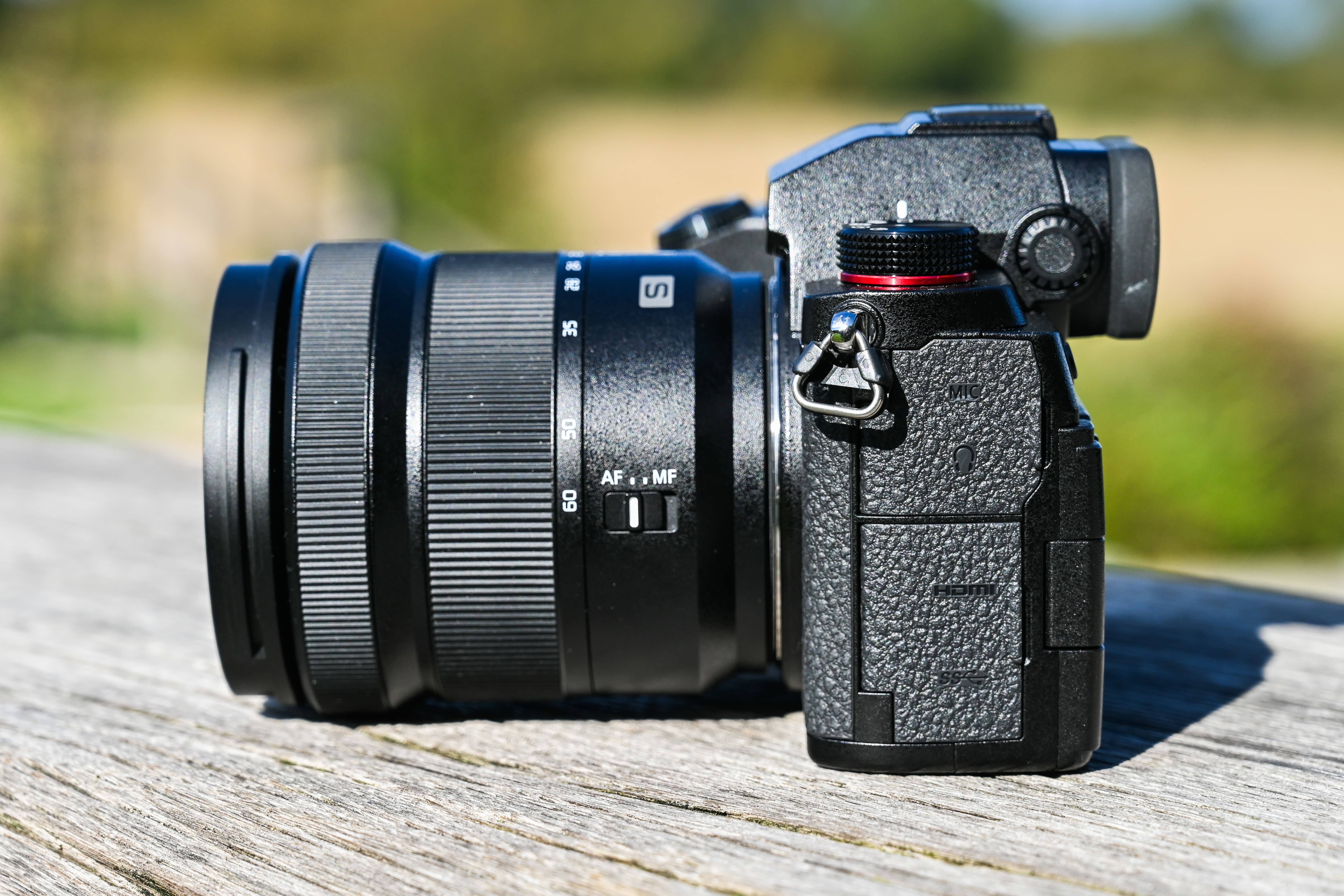
The Lumix S5 was supplied with three lenses for review. Here’s it’s paired with the Lumix S 20-60mm F3.5-5.6
Behind its L-mount the S5 features the same 24.2MP full-frame CMOS sensor as found inside the Lumix S1. This chip combines with a Venus Engine processor to provide a sensitivity range of ISO 100-51,200, which can be extended to ISO 50-204,800.
It shoots a continuous burst at 7fps with fixed focus (AFS), or 5fps with continuous AF (AFC), which works out 2fps and 1fps slower respectively than the Lumix S1. If this isn’t fast enough there’s the S5’s 6K/4K Photo modes to fall back on. These can be used to extract 18MP JPEG images at 30fps, with 4K Photo offering sequences up to 60fps albeit at a lower 8MP resolution.
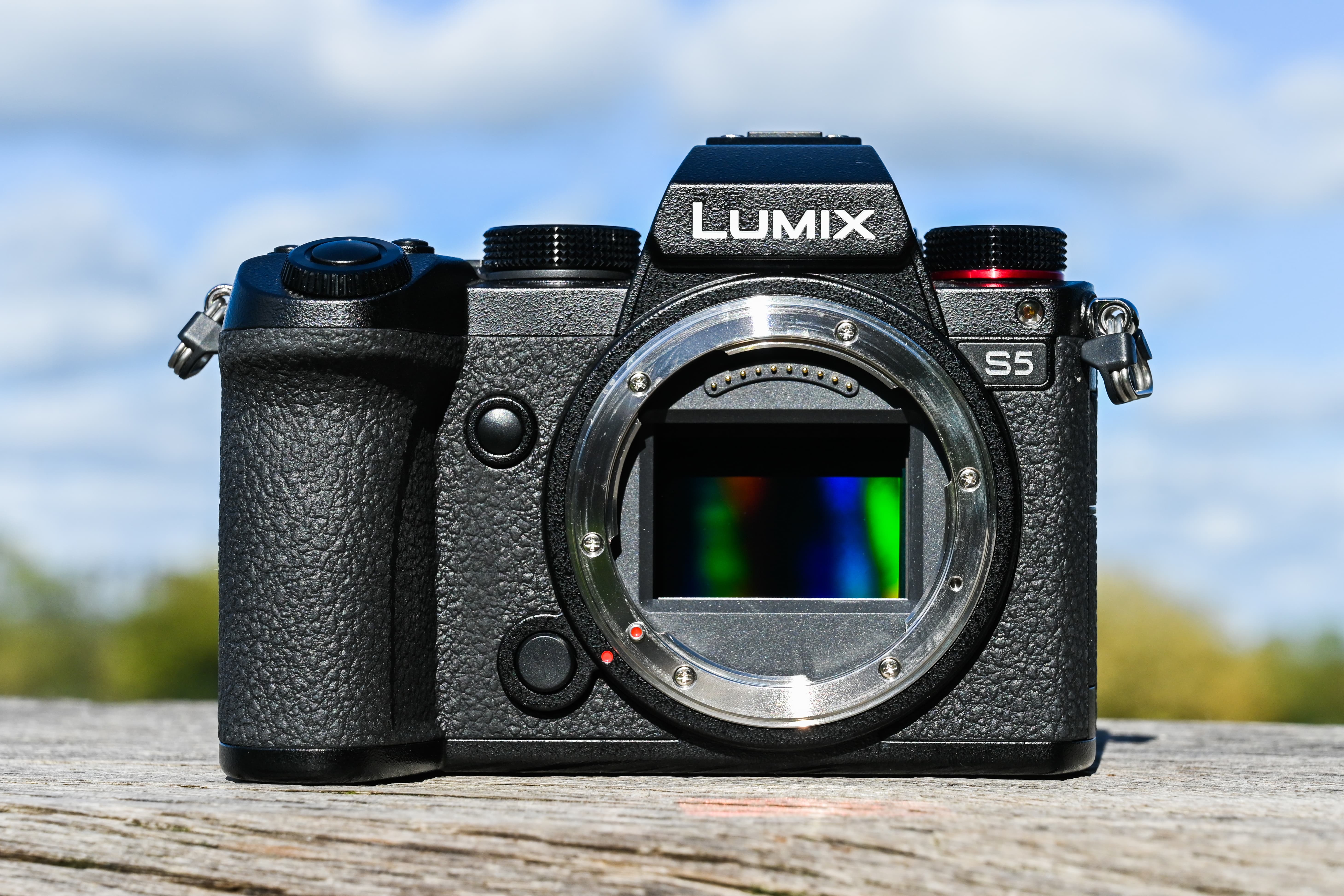
The Lumix S5 has a single function button at the front and the lens release button is located beneath. This is different to the Lumix S1, which has two function buttons beside the lens mount
As well as a mechanical shutter, there’s an electronic shutter for silent shooting. The fastest shutter speed is capped at 1/8000sec and the slowest it can be set to is 60secs. To keep handheld shots sharp and alleviate shake in handheld video footage, 5-axis in-body stabilisation (IBIS) is present.
It operates in co-operation with optically stabilised lenses via Panasonic’s Dual I.S. 2 system to provide a maximum of 6.5 stops of stabilisation. It works exactly the same way as the Dual I.S.II system on the Lumix S1/S1R, combining 2-axis stabilisation from the lens with 5-axis stabilisation in the camera.
Any lens that’s mounted benefits from in-body stabilisation, however you are requested to input the focal length of any manual lenses when the camera is turned on.

A view of the top plate. Note the drive dial to the left of the viewfinder and mode dial to the right
Like the S1, the S5 is capable of producing high-resolution 96MP (12,000×8000 pixel) files by merging together image information recorded from eight consecutive exposures taken as the in-body image stabilisation system makes subtle adjustments to the position of the sensor.
Whereas the S1 only recorded high resolution raw files, the S5 outputs its 96MP images in either Raw or JPEG file formats. By setting the motion blur processing mode to mode 2, the camera attempts to eliminate blurring artefacts, which can occur when an object moves ever so slightly between exposures.

The various options you’re presented with in the S5’s High Resolution Mode. Users now have the option to output high-resolution JPEGs as well as Raw files
Those wondering how else the S5 advances on existing models will be interested to read that autofocus in both photo shooting and video recording has been improved.
Changes to the camera’s Depth From Defocus (DFD) technology that works with contrast detection is claimed to improve tracking of small and fast-moving subjects in AFC mode, while the S5’s deep learning technology is able to differentiate detection between specific subjects – humans and fast-moving animals, including dogs, cats and birds.
Notably for humans, in addition to the eyes, face, and body, the head is also recognised by real-time detection technology, with the ability to keep tracking a person if they move quickly, turn their back, tilt their head or move far away.
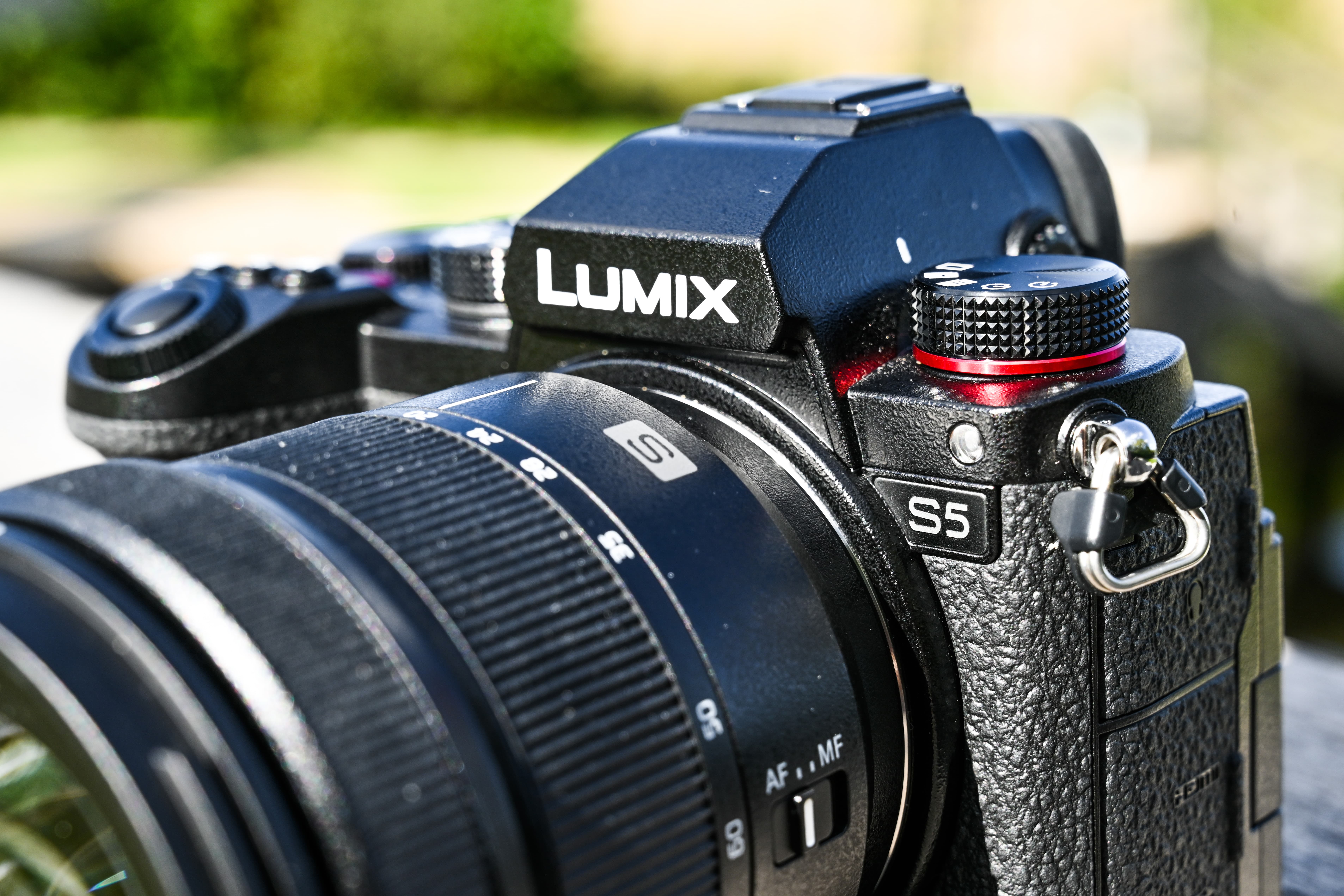
An anodised red ring below the drive dial adds a little colour to the all-black finish of the S5
Panasonic’s S1 presented an impressive video specification and it’s a similar story with the S5. It’s capable of 4K 60p 4:2:0 10-bit recording internally with an APS-C crop and also records 4K/30p footage internally with 4:2:2 10-bit colour using the full width of the sensor for up to 30 minutes.
In addition 4K 60p/50p 4:2:2 10-bit output via HDMI is possible and there is no time limit when recording 4K 30p/25p 4:2:0 8-bit internally. At the side you’ll find 3.5mm stereo headphone and mic sockets under a shared hinged rubber cover, along with USB-C and full-size HDMI ports.
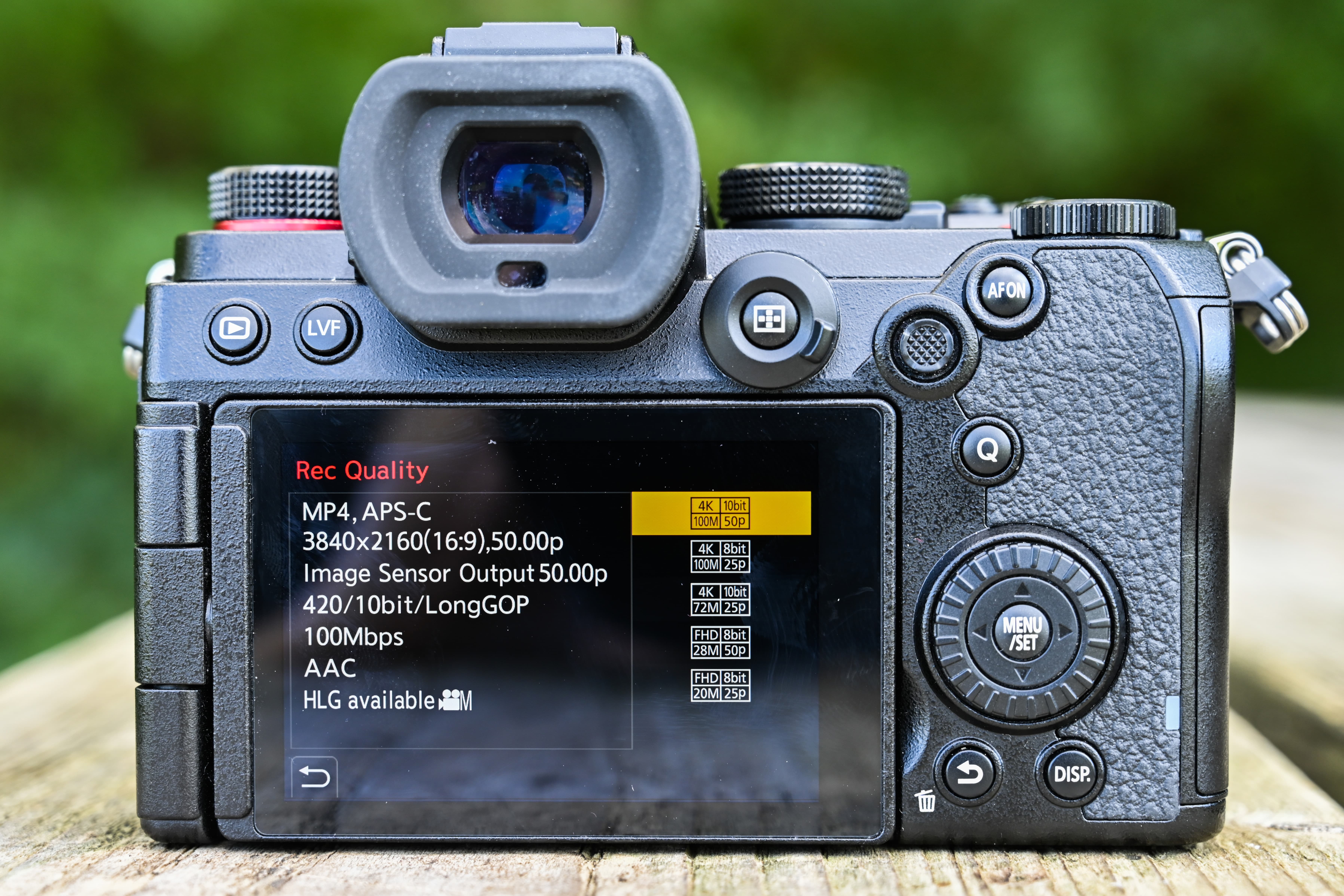
The Lumix S5 applies an APS-C crop when recording 4K 60p 4:2:0 10-bit (100Mbps) internally
Videographers will also be grateful to find V-Log preinstalled, which doesn’t require additional expense for a software key. Furthermore, HDR recording in 4K is available, and support of RAW video output over HDMI at 5.9K/29.97p/25p, 4K/60p/50p and Anamorphic 3.5K/50p will be available via a forthcoming firmware update.
Rather than accepting an XQD and SD card, the S5 has twin SD card slots, though only one is compatible with UHS-II type cards.
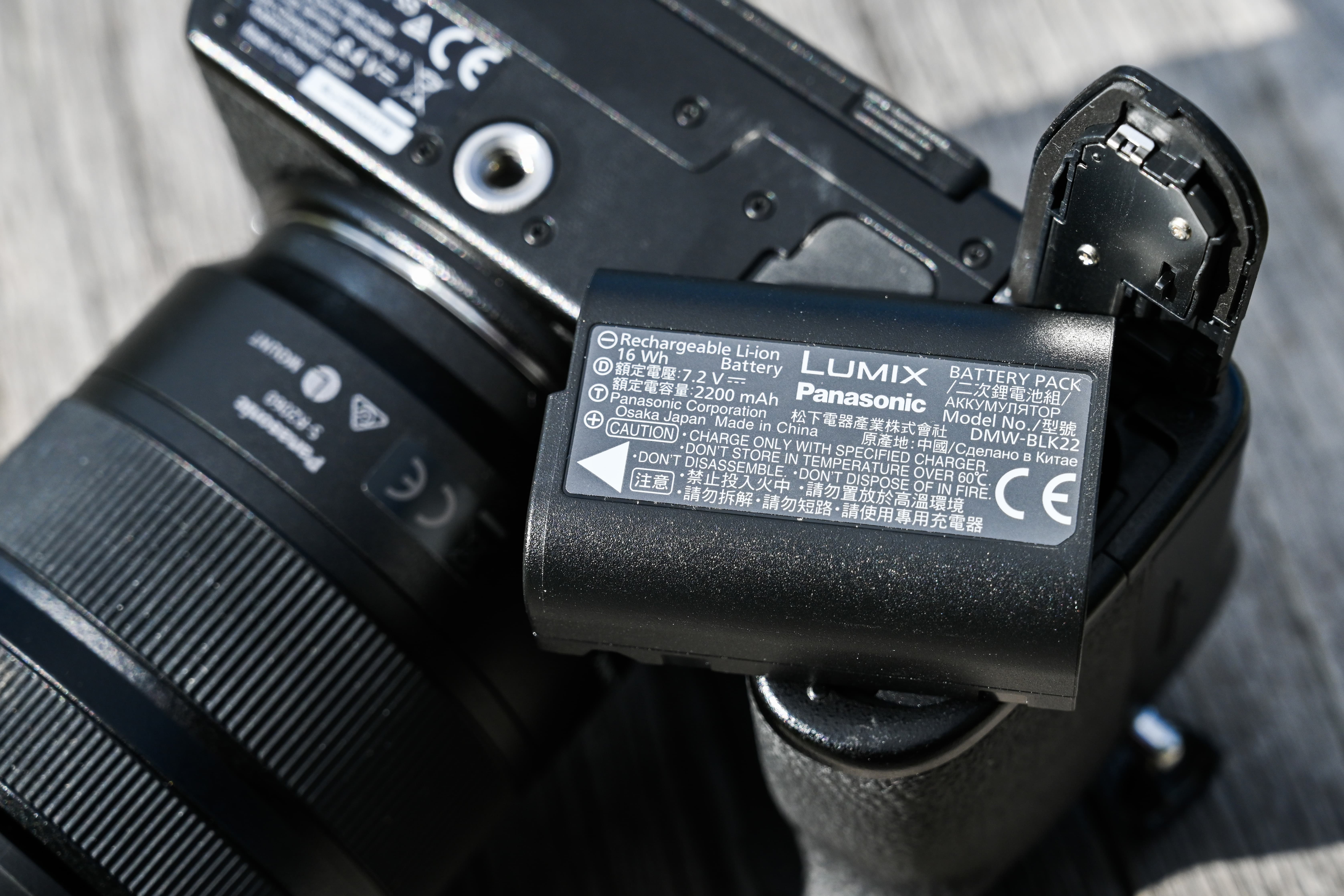
The Panasonic Lumix DMW-BLK22E rechargeable battery. Spares cost £74 each
A new 2,200mAh battery provides stamina for 470 shots on a single charge and Panasonic claims up to 1,500 shots are possible by entering its Power Save LVF mode. Take advantage of the S5’s Bluetooth and Wi-Fi connectivity in combination with Panasonic’s Lumix Sync app and users can also control the camera remotely as well as select images to copy to a mobile device.
Panasonic Lumix S5: Focal points
It’s Panasonic’s most affordable full-frame camera, but the S5 certainly isn’t light on advanced features.
- S&Q mode: S&Q mode stands for ‘slow and quick’ and is selected directly from the mode dial. When selected users have the option to quickly adjust the frame rate. In 4K the frame rate can be set between 1-60fps, whereas in Full HD resolution it can be set between 1-180fps.
- Audio quality: Advanced audio quality is available using Panasonic’s optional DMW-XLR1 microphone adapter, allowing pro-spec microphones and XLR input sources to be connected. It is ideal for lip-sync recording and has dedicated switches to allow direct, quick control.
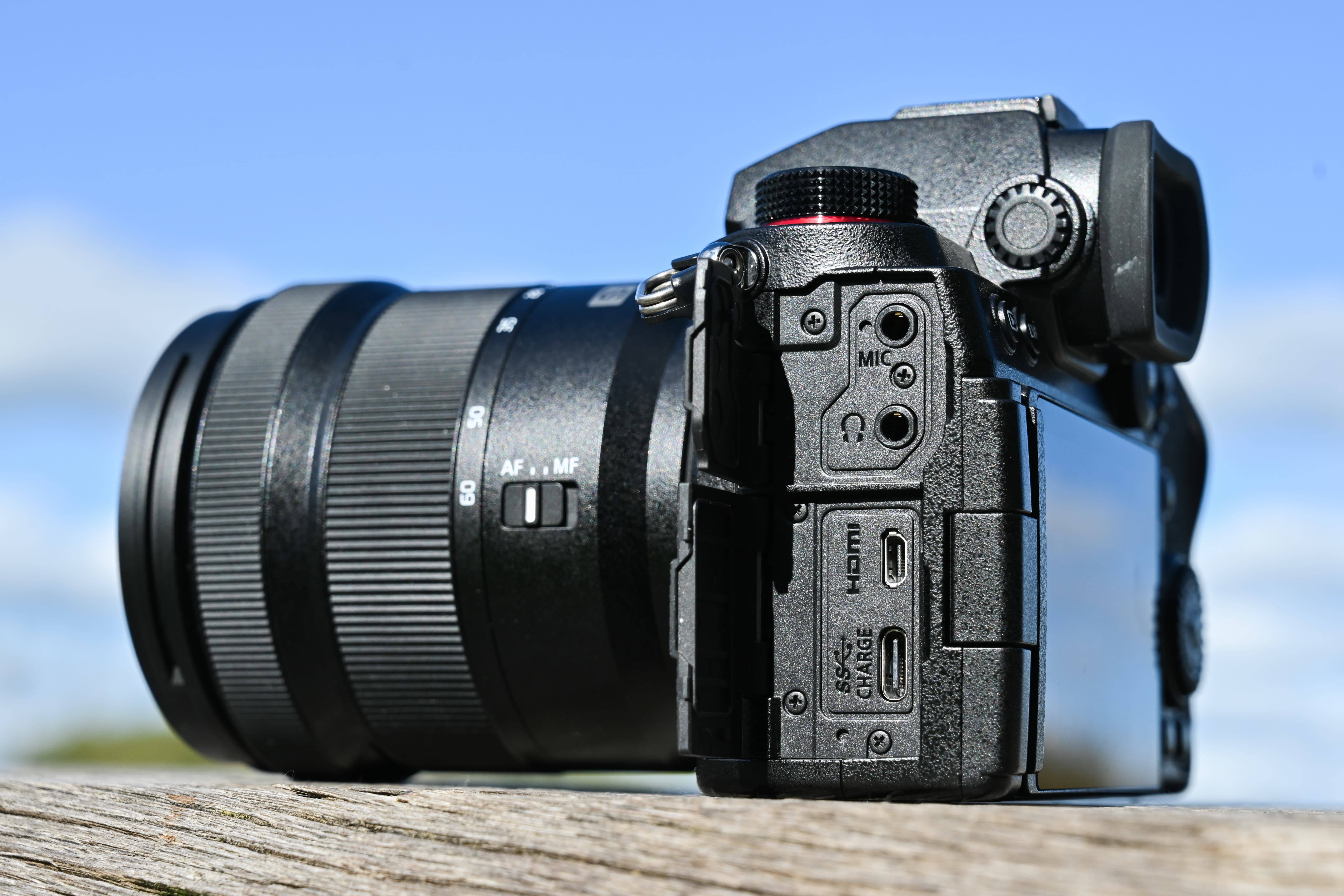
The S5 features USB 3.1 Gen1 Type-C and microHDMI TypeD interfaces at the side. Above these you’ll find 3.5mm microphone and headphone ports
- Dual Native ISO: The S5 features dual native ISO circuitry, which is also found on the Panasonic Lumix S1H. Dual-Native ISO technology exploits the camera’s sensor information to extend its dynamic range and allow for higher ISO movie shooting with lower visible noise. It’s designed to make noisy low-light video footage a thing of the past.
- Battery grip: Panasonic has made a dedicated battery grip for the Lumix S5 – the DMW-BGS5E (£257). It accepts an additional DMW-BLK22 battery and increases the stamina to 940 shots using the electronic viewfinder, or 3000 shots by selecting Power Save LVF mode.
- Optional accessories: The Lumix S5 is supported by other accessories, including the DMW-RS2 wired shutter remote and DMW-SHGR1 tripod grip. Those who’d like to pair it with an external flash can choose between the DMW-FL580L, DMW-FL360L and DMW-FL200L.
Panasonic Lumix S5: Build and Handling
It can be difficult to gauge an impression of size by looking at pictures alone. As already briefly mentioned, the S5 is more compact than the three S-Series models that have come before it. This is welcome news as the sheer bulk of the S1 and S1R was one of our criticisms when we reviewed the pair last year.

Michael Topham tests the Lumix S5. The body weighs 714g with battery and card included
So exactly how much different are we talking? Well, in terms of weight, the S5 sheds 300g off the Lumix S1/S1R and is even lighter than Panasonic’s Lumix GH5. It’s not as light as its main full-frame rivals, but the weight and size difference compared to where Panasonic started out in full-frame is immediately obvious the first time it’s handled.
You still get a large grip to wrap your hand around and although I’d have liked to see the thick textured rubberised coating continue past the memory card door at the side, the camera feels very secure when it’s held to your eye and used single handed.
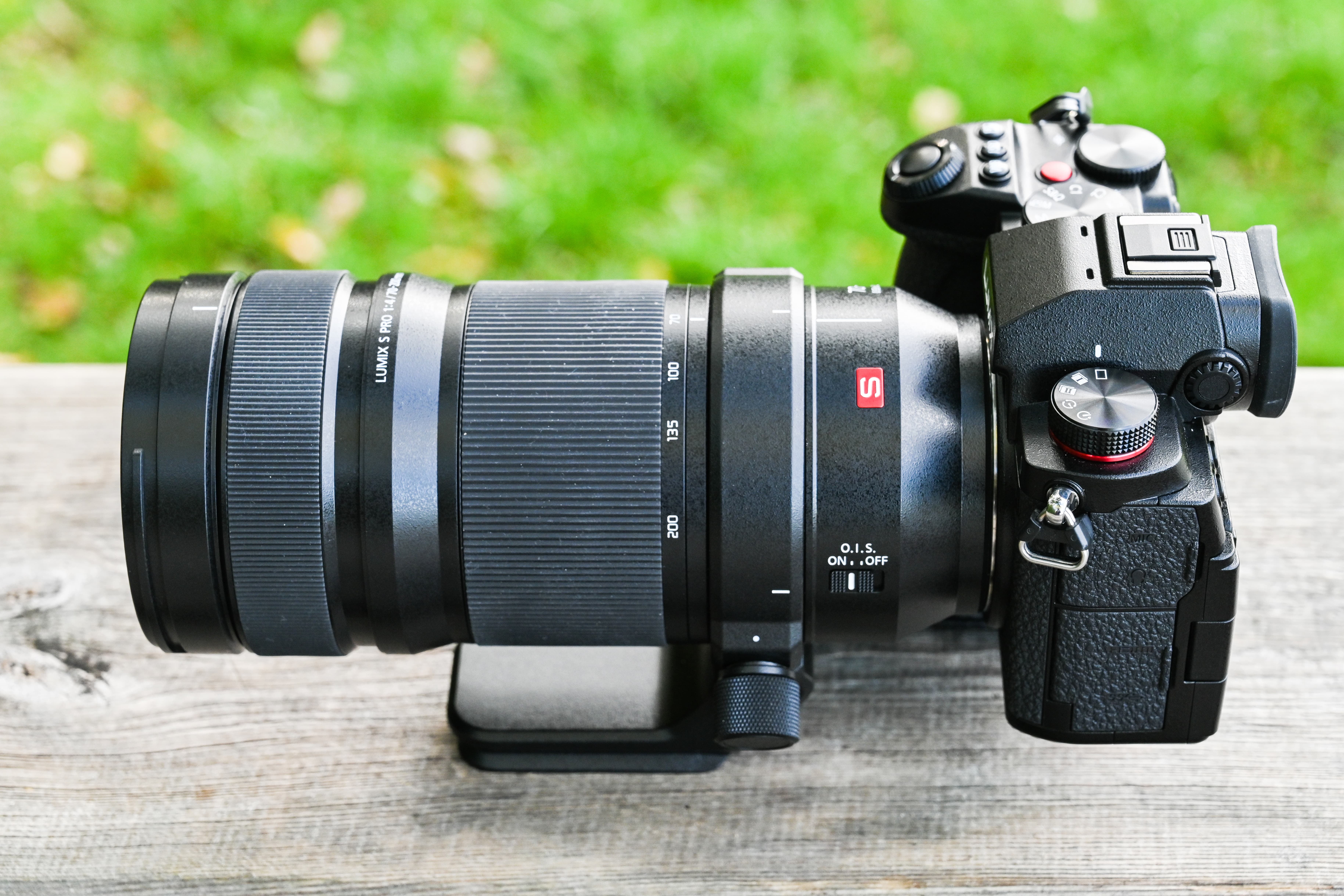
The Lumix S5 paired with the Lumix S PRO 70-200mm F4 O.I.S lens
Operating the S5 with the Lumix S PRO 70-200mm F4 O.I.S was enjoyable. If I were to be critical and judge it against rival camera’s handgrips I’d say I prefer the overall feel of the S5’s grip to that of Sony’s A7 III, however I favour the rounded lower corners of the Nikon Z5/Z6 and Canon EOS R’s grips, which make them feel that bit more comfortable to hold over long periods.
With less space on the top plate, Panasonic has opted to separate the drive dial from the mode dial and place both either side of viewfinder and hotshoe. The front dial encircles the shutter button whereas it’s separate on the S1/S1R. It rotates a little too freely for my liking and doesn’t uphold the same high quality feel as other areas of the body. The same is true of the focus mode switch and rear dial, which also have a bit of a plasticky feel to them.
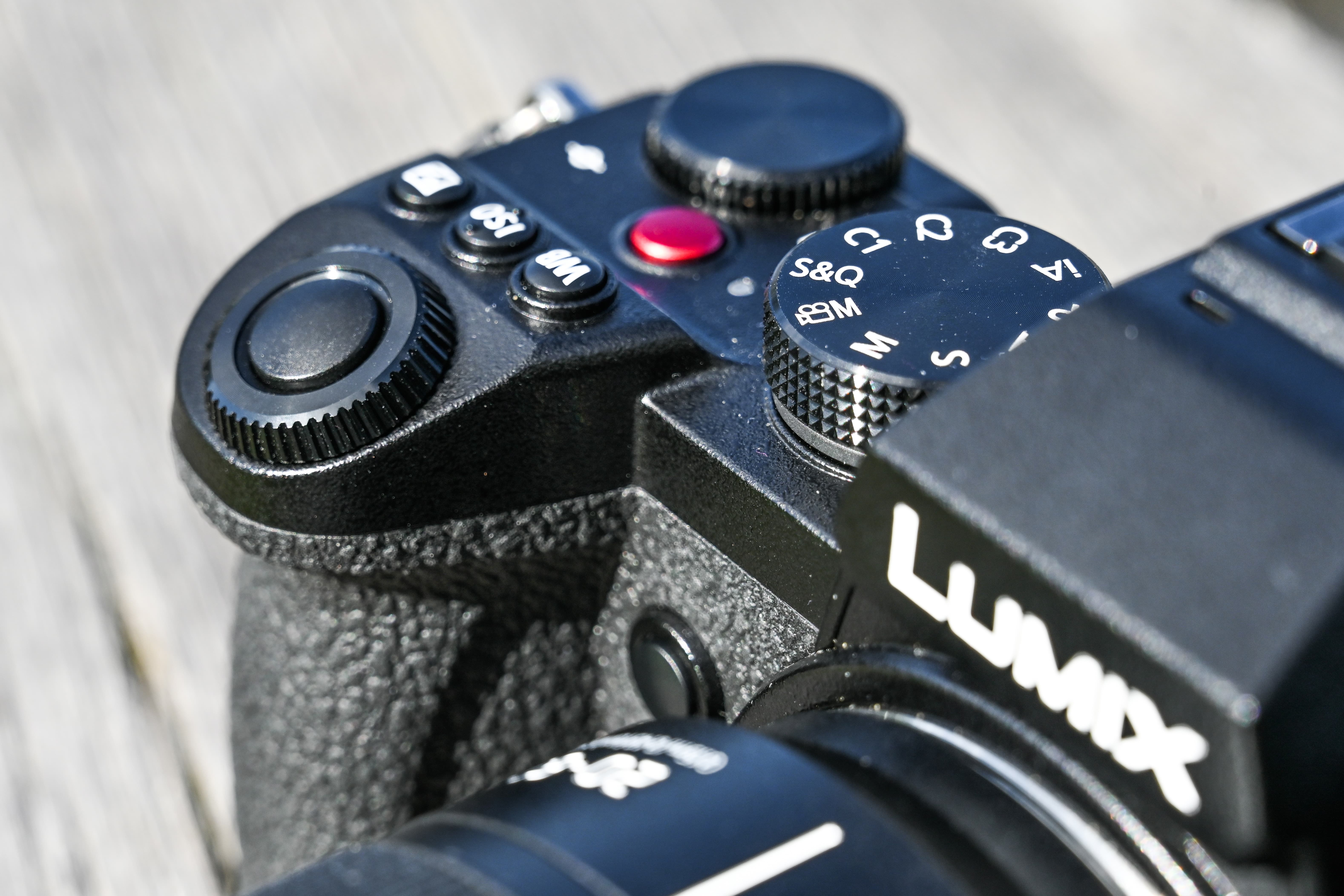
The plastic front dial lets the quality of the S5’s build down a little
The level of control you get at your fingertips is excellent, with the option to customise no fewer than 16 Fn buttons on the body in record mode. Different commands can also be assigned to different buttons in playback mode too. Three prominent buttons behind the shutter release access exposure compensation, ISO and white balance. A rather cute idea is the way the latter two can be pressed continually to increase sensitivity setting or cycle through the white balance modes.
Elsewhere, the red movie-rec button no longer requires users to stretch their thumb to access it from the rear. It’s accessed from the top plate and the touchscreen interface lets you dive in and adjust many common settings on the fly via large onscreen icons.

The Lumix S5 fits the average-size hand well
There’s much more positive to say than there is to fault overall when reflecting on the quality of the S5’s build and handling. It’s solid, it feels well made aside from the aforementioned dials and although Panasonic don’t give too much away about the extent of the cameras weather and dust resistance, I experienced no issues or faults operationally as a result of it getting absolutely drenched on a wet city break to York.
The Lumix S1/S1R do present their own advantages in that their rear buttons illuminate in the dark, they offer a pair of function buttons beside the lens mount and provide an informative LCD panel on the top plate to glance at, but ultimately it’s the reduced size and weight of the S5, combined with its fine ergonomics and wide customisable control that makes it the most enjoyable S-series camera we’ve used to date.
Panasonic Lumix S5: Viewfinder and screen
Understandably, a few compromises were always going to have to be made in order for Panasonic to sell the S5 at £1799 (body only) from launch. One of these is its 2.36-million-dot electronic viewfinder that doesn’t match the sensational 5.56-million-dot OLED viewfinder as used by the S1, S1R and S1H.
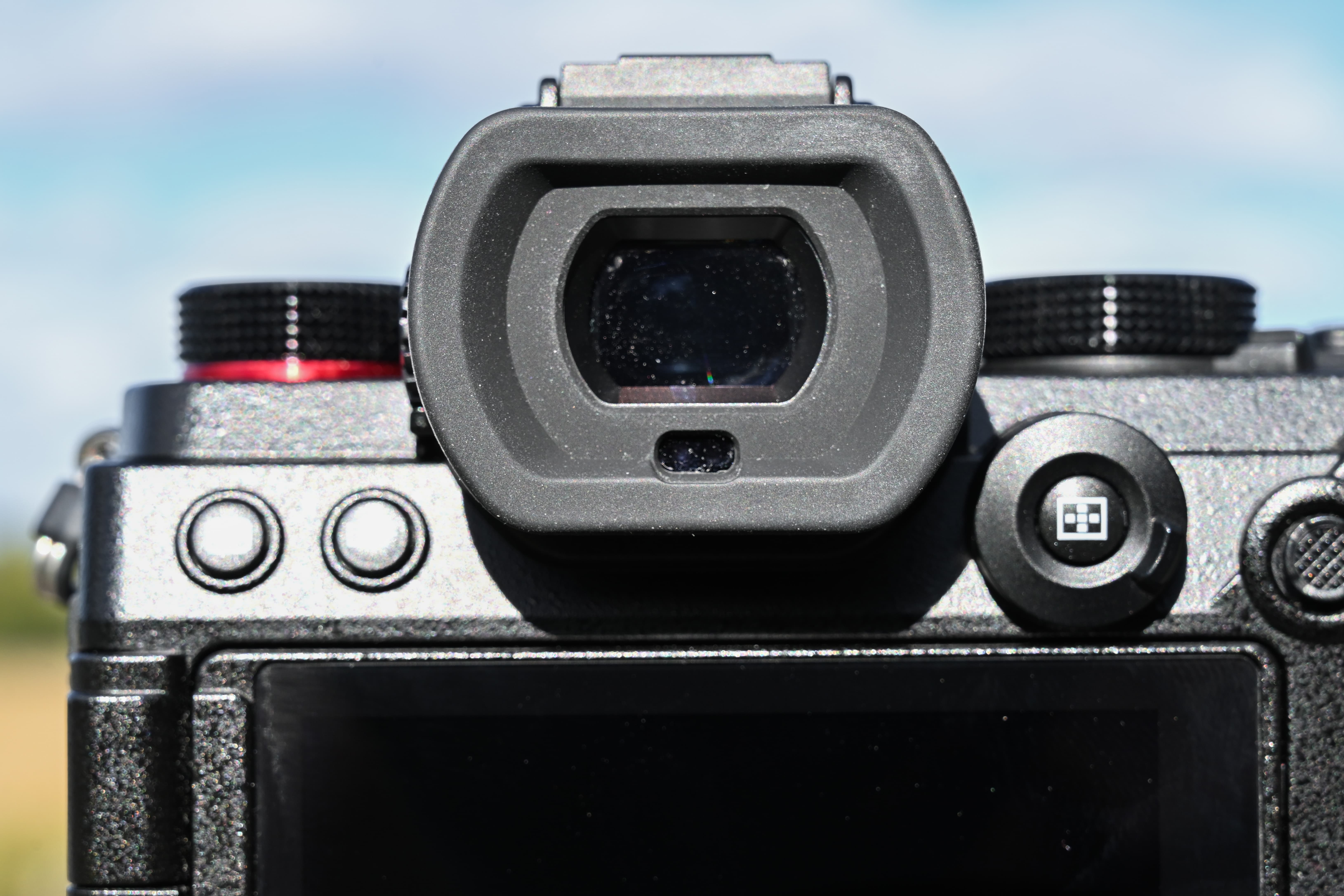
The sensitivity of the eye sensor that’s located below the viewfinder can be set to High or Low
The S5’s EVF has a magnification of 0.74x, a display time lag of just 0.005secs and a display speed of 60fps that can be upped to 120fps for the smoothest viewing experience possible at the cost of slightly reduced battery life. It should be said the EVF, which Panasonic refer to as the LVF (Live View Finder), doesn’t provide the same wow factor as the finest examples on the market today, however it displays consistent colour with the rear screen and the rubber eyecup provides good cushioning.
My only criticism is that the behaviour of the feed switching from the rear screen to the EVF is a tad sluggish, which persisted when I changed the eye sensor sensitivity from low to high. This, and the fact displayed information doesn’t rotate in the EVF when shooting in the portrait orientation, are small areas for improvement.
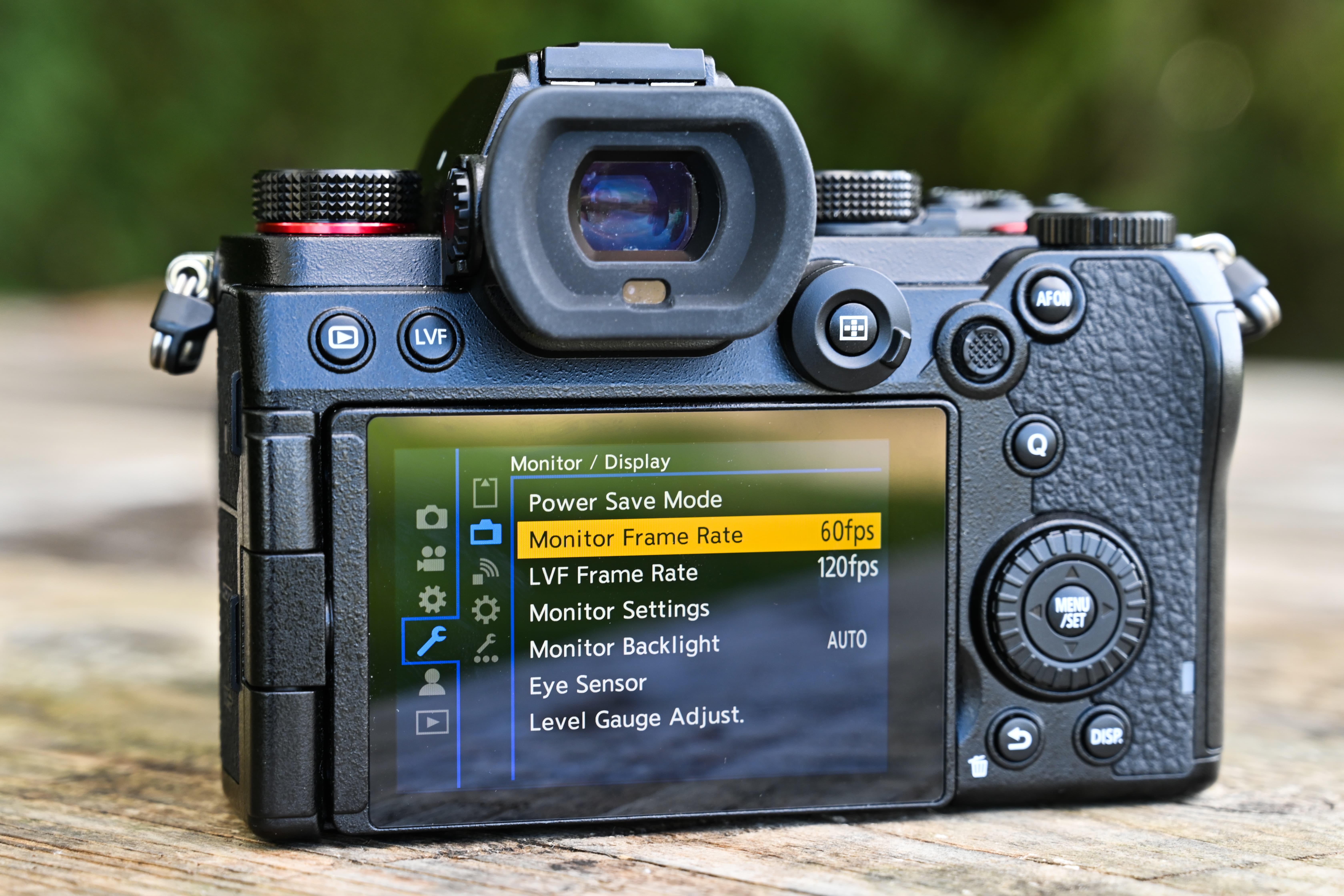
Here the frame rate of the electronic viewfinder has been increased from its 60fps default setting to 120fps for the finest viewing experience
Rather than adopting the triaxial tilting type of rear screen, the S5 features a more conventional vari-angle display. It’s a 3in, 1.84-million-dot OLED panel that users can manoeuvre in all directions, including forwards for vlogging and the occasional selfie.
The downside compared to a triaxial tilting screen is its manoeuvrability when an L-bracket is used. Plugging into the headphone, HDMI and USB-C ports also obstructs the screen being tilted to certain angles.

The S5’s touchscreen responds well to light finger presses. Here we see the information screen displaying various icons, allowing users to make quick adjustments by touch
The panel responds well to light touches and lets you navigate the new two-tier menu system precisely. A double tap of the screen in playback takes you to 2x-magnified view, with the rear dial allowing you to inspect the precise area that’s touched up to 16x magnification.
Panasonic Lumix S5: Autofocus
Panasonic understands the importance of focus control and places what you need in easy reach of your right thumb. The joystick and AF-ON buttons are well positioned and to the left of these you get the AF-area button that’s combined with an AF mode switch. There’s no looking around the body to get the S5 setup as you want it to focus, however when you use the joystick you’ll notice it only reacts to horizontal and vertical movements. It doesn’t let you to shift the AF point diagonally across the frame like you can when using the touchscreen.

Panasonic Lumix S5, Lumix S 70-200mm F4, 1/250sec at f/4.5, ISO 800 (Animal detection)
With the AF point selected you can set it to one of eight sizes in 1-Area AF mode using the rear dial and fine-tune the size of the AF point extremely precisely using the front dial. It provides two good Zone AF modes (vertical/horizontal and oval) for action/sports photography and pinpoint AF for focusing very precisely on a subject with a central magnified view onscreen.
Testing the Face/Eye/Body detection revealed it’s responsive at recognising multiple faces in the frame, but with the viewfinder raised to your eye there’s no easy way to select which face you’d like the camera to prioritise on – something I’d have liked to be able to do using the joystick.

Panasonic Lumix S5, Lumix S 70-200mm F4, 1/100sec at f/4, ISO 800 (Face & Eye detection)
Eye detection is revealed as a thin cross-section within the face detect area. This isn’t as obvious as some other camera manufacturers eye detection modes that reveal a highlighted colour square over the eye. Though I found it to be accurate and reliable in good light, there isn’t an obvious way to specify between your subject’s left and right eye, plus it struggled to identify eyes in some tricky backlit scenes.
Animal detection was put to good use to help capture a few cat portraits, but my lasting impression is that the S5’s Face/Eye/Body/Animal detection is still some way off Sony’s Eye and Animal AF, which continues to be the standout leader in its field.

Panasonic Lumix S5, Lumix S 70-200mm F4, 1/3200sec at f/4, ISO 1600
Photographing a local game of football in daylight at 5fps with continuous focus (AFC) confirmed that it can keep up with fast action and it didn’t appear to pulse for focus like we experienced with the S1/S1R. When light levels drop and it’s asked to focus in extremely dark situations where its AF assist beam is ineffective, users should be prepared to be patient as focus speed does take a hit and isn’t as instantaneous.
Panasonic Lumix S5: Performance
The Lumix S1 and S1R were observed as being a tad sluggish re-entering shooting mode from playback mode, but thankfully this seems to have been addressed on the S5. Tap the sensitive shutter button after reviewing images and you’re ready to start shooting again immediately with no infuriating delay.
Equally as impressive is the S5’s start-up speed. Though I’d prefer it if the on/off button had been combined with the shutter button for intuitive control with my index finger, much like the Lumix G9, you can’t argue at how quickly the S5 springs to life from a cold start and its power-saving sleep modes.

Panasonic Lumix S5, Lumix S 20-60mm F3.5-5.6, 1/400sec at f/9, ISO 800
The icon in the top right hand corner of the screen and EVF, which displays the function of the image stabiliser is useful to glance at. It changes automatically based on the lens you’re using and clearly reveals when the IBIS system is working with a lens that features optical image stabilisation and when it isn’t.
Users will just want to remember to change the operation mode to Panning (Auto) when tracking moving subjects and choose the activate on a half press of the shutter option rather than the always active setting to conserve battery power. On the topic of battery power, it’s handy having the option to top-up on the go between locations via USB-C. Being able to power the camera as it’s recording also means your workflow is never interrupted.

Panasonic Lumix S5, Lumix S 70-200mm F4, 1/2000sec at f/4, ISO 800
The more I used the S5, the more I found myself assigning functions to its impressive array of customisable buttons. With the option to setup a personalised My Menu, three custom modes that can be directly accessed from the mode dial and different burst settings to the two burst modes from the drive dial, you couldn’t ask for better customisable control.
There are some useful hidden shortcuts too. In playback mode you can multi select images to send to a smartphone by tapping the Q button, whereas a press of the AF-ON assigns a pre-selected star rating to a shot. Another nice touch is having the option to depress the joystick to move between the central AF position and your last used AF point.
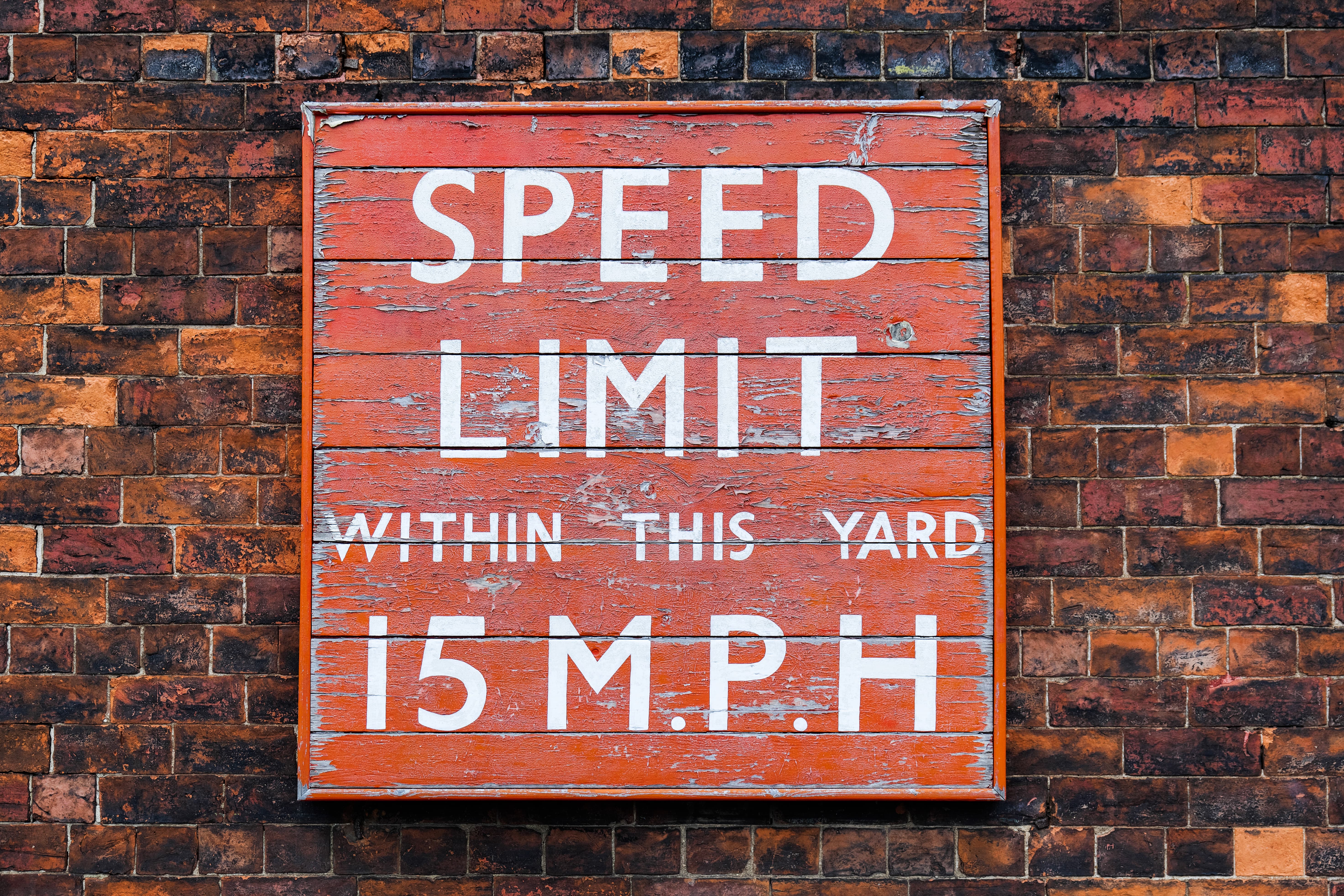
Panasonic Lumix S5, Lumix S 20-60mm F3.5-5.6, 1/125sec at f/6.3, ISO 400
Throughout a majority of my testing I left the metering mode set to the S5’s multi-zone setting. It calculates the light in divided areas across the frame and determines the average exposure for the overall scene effectively. I rarely found myself adjusting exposure compensation, but on the times I did, I only gave the image an exposure lift of +0.3EV or 0.7EV.
To give my images a warmer appearance straight out of camera, I opted to use the AWBw Auto White Balance mode most of the time. For cooler looking results users may wish to use the standard AWB and AWBc (cool tint) modes. Alternatively, users can specify the white point from one of four white set capture modes or opt to dial in the colour temperature (2500k-10k) manually.

Panasonic Lumix S5, Lumix S 20-60mm F3.5-5.6, 1/5sec at f/5.6, ISO 6400
Loading a Panasonic V90 64GB SDXC Class 10 memory card into the S5’s only UHS-II compatible card slot resulted in it being able to record 26 Raw and Fine JPEG files at 7fps, increasing to 37 frames when shooting in Raw and an unlimited number of Fine JPEGs. Switching the focus mode to continuous (AFC) sees the burst rate drop to 5fps. At this speed, 33 Raw and Fine JPEG files were recorded before the buffer was hit and time was needed for it to clear.
I’ve always been impressed by how well Panasonic’s high-resolution mode works, which on the S5 stitches together data from eight consecutive shots taken in quick succession to create one large 96MP high-resolution image. It’s incredibly easy to use, with options to simultaneously record a normal shot at the same time and add a shutter delay (1/8sec-30secs) to reduce the risk of knocking the camera at the start of an exposure.

Panasonic Lumix S5, Lumix S 20-60mm F3.5-5.6, 1/10sec at f/5.6, ISO 2000
Things to bear in mind are that you’re required to tap the Q button to exit high-resolution mode and the sensitivity is capped at ISO 3200. It’s great to see Panasonic adding the option to create high-resolution JPEGs and there’s only a very brief delay before high-resolution images are rendered clearly via the screen and EVF at high magnification.
What’s most remarkable though is how well the S5 suppresses motion blur in situations where faint movement is detected in a scene. Activating Motion Blur Processing Mode 2 and photographing the front of a hotel where a flag was blowing in the wind, and other scenes in which tree branches were swaying, didn’t cause a problem for the S5’s internal image rendering. It doesn’t work well with flowing water, smoke or steam, but the way it recognises and deals with subtle movements with no perceptible trace of motion blur is extremely impressive.

Panasonic Lumix S5, Lumix S 70-200mm F4, 1/2000sec at f/4, ISO 1600 (6K Photo mode)
Testing the 6K/4K photo modes at a game of football demonstrated that these can help pick out a fleeting moment of action, however the 6K mode does put strain the processor to the point I did have to wait at times for the camera to play catch up before saving an 18MP still image. It’s worth noting the 6K/4K Photo noise reduction that’s automatically applied when an image is saved is aggressive and you’ll find still images taken out of 6K/4K mode yield finer detail and clarity.
With the same sensor at its heart as that used within the Lumix S1, there’s nothing new to report in terms of resolution output or noise control. You get crisp, detailed images and high ISO noise is well controlled in Raw files to the point I wouldn’t hold back from using ISO 12,800, or even ISO 25,600 if a low-light situation demanded it.

Panasonic Lumix S5, Lumix S 20-60mm F3.5-5.6, 1/80sec at f/6.3, ISO 25,600
In addition to shooting images across the full sensor width in the 3:2 aspect, users have the option to compose and shoot using 4:3, 16:9, 1:1, 65:24 and 2:1 aspect ratios.
Panasonic Lumix S5: ISO and noise
With the same sensor as that used within the Lumix S1, there are no surprises regarding the resolution the sensor resolves or the way it handles noise. You get crisp, detailed images at low sensitivity settings, which is preserved high into the ISO range. Noise does start to creep in a little at ISO 3200 and ISO 6400, however the fine detail that is resolved at these settings is impressive. Even at ISO 12,800 files are usable, though images could benefit from a touch of extra luminance noise reduction over Adobe’s default settings.
ISO 25,600 can be used if low-light situations demand it (see the sample image above) and it’s only when you start to encroach ISO 51,200 that colour noise starts to make its presence known. Based on this I’d set the upper sensitivity limit to ISO 25,600 or ISO 40,000 when using Auto ISO. Fine detail suffers heavily at the top two sensitivity settings, so while it might sound good to have the option to push to ISO 102,400 and ISO 204,800, you’ll rarely want to use them.
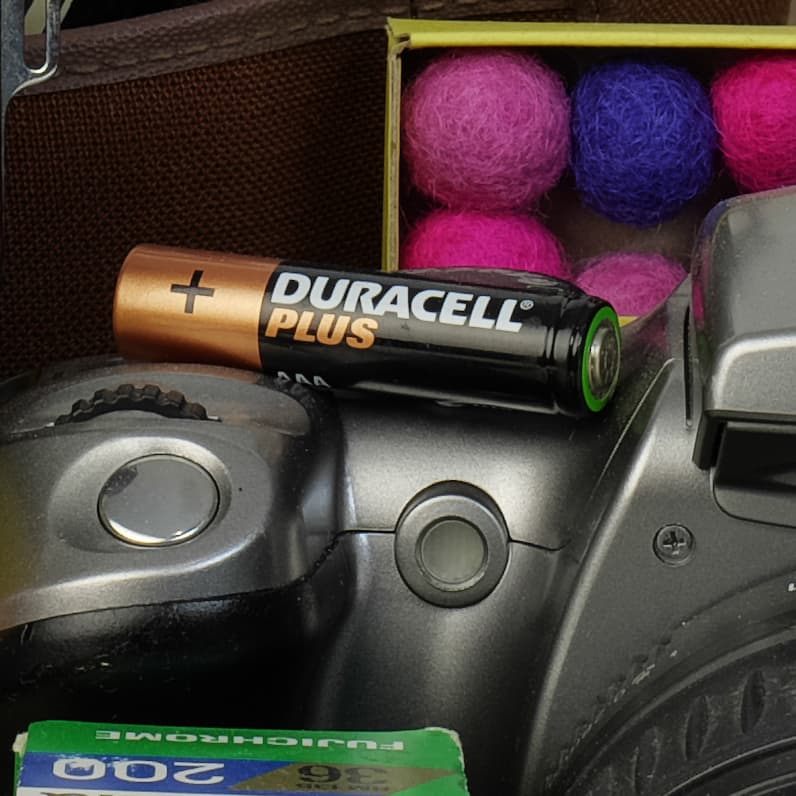
Lumix S5, ISO 100, Raw + Adobe Camera Raw, 100% crop
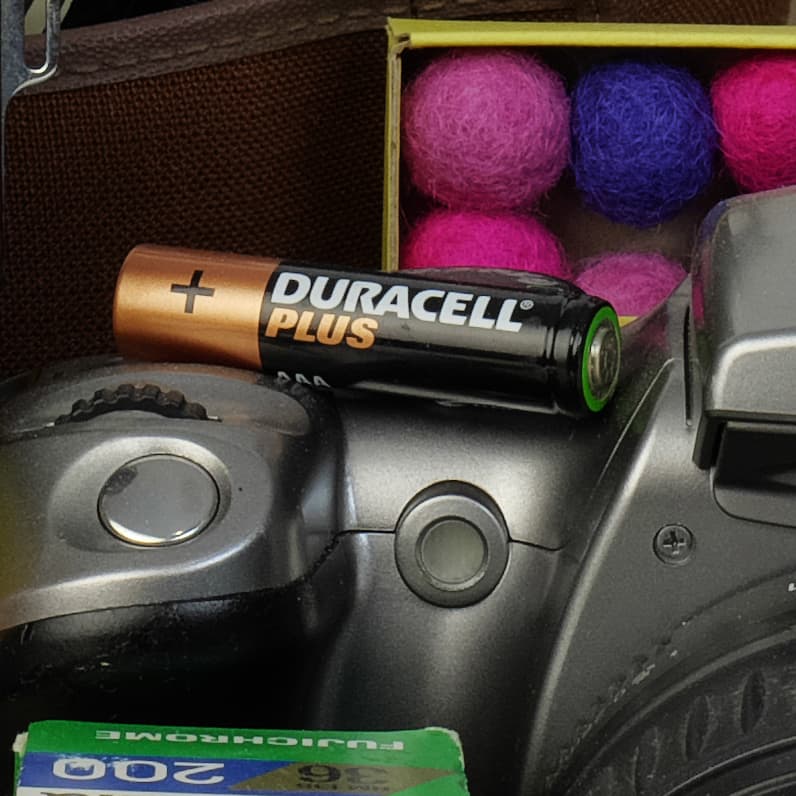
Lumix S5, ISO 800, Raw + Adobe Camera Raw, 100% crop
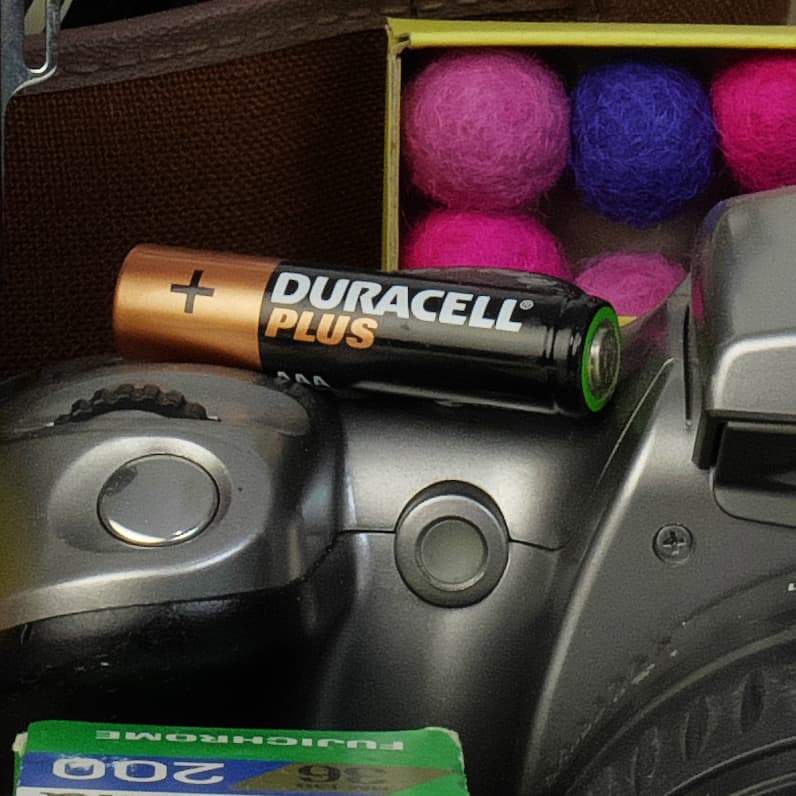
Lumix S5, ISO 6400, Raw + Adobe Camera Raw, 100% crop
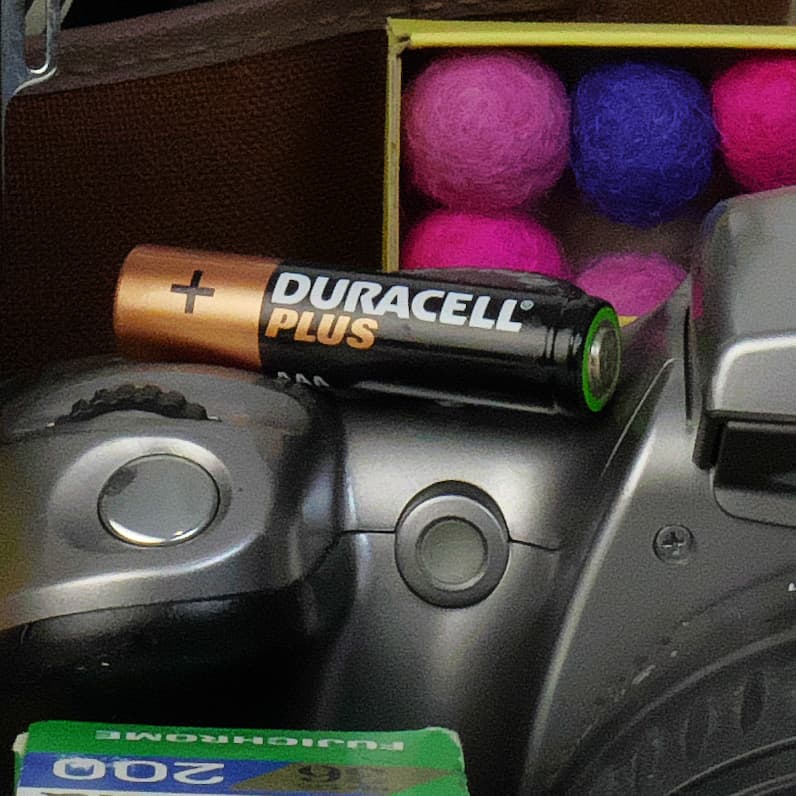
Lumix S5, ISO 12800, Raw + Adobe Camera Raw, 100% crop

Lumix S5, ISO 25600, Raw + Adobe Camera Raw, 100% crop
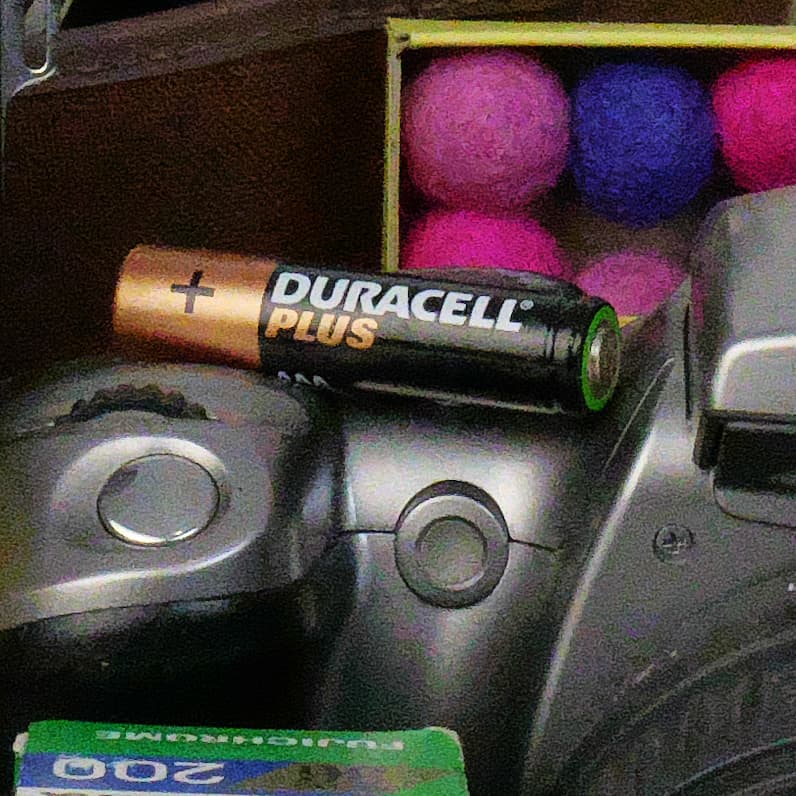
Lumix S5, ISO 51200, Raw + Adobe Camera Raw, 100% crop

Lumix S5, ISO 102400, Raw + Adobe Camera Raw, 100% crop

Lumix S5, ISO 204800, Raw + Adobe Camera Raw, 100% crop
Panasonic Lumix: Verdict
With the Lumix S5, Panasonic set their sights on creating a hybrid mirrorless camera that’ll attract different types of users – passionate stills photographers who yearn fine image quality from a full-frame sensor combined with good ergonomic control, as well as videographers who demand cinema-quality video performance with highly effective in-body stabilisation, 4K 4:2:2 10-bit HDMI output and preinstalled V-Log.

Although not perfect, the Lumix S5 is an impressive full-frame camera for the money
There’s a great deal to like about the S5 as a stills camera. Image quality, particularly the level of fine detail recorded in raw files at high ISO is outstanding. This is backed up by an easy-to-use high-resolution mode and a quite brilliant 20-60mm kit lens that lets you squeeze more in the frame than most kit zooms.
Users get a well thought out arrangement of buttons and dials and Panasonic’s contrast-based DFD autofocus system has improved. This was evident tracking erratic subjects in AF-C mode, however it did struggle to acquire focus in some low-light scenes, which is where its phase-detection mirrorless rivals still have an upper hand. The other thing to bear in mind if you regularly shoot action or sport is that it doesn’t shoot as fast as the Sony A7 III or Nikon Z6.

The Lumix S5 handles better than any other Panasonic S-series full-frame camera we’ve tested previously
The big talking point is the S5’s body and handling, which addresses concerns of Panasonic’s full-frame S-series being too large and heavy. The S5 is much closer in terms of size to its main rivals and presents a weight saving that many DSLR users look for when transitioning to mirrorless – something the Lumix S1 and Lumix S1R failed to do.
The balance and feel with L-mount lenses is so much better it makes us question why Panasonic didn’t make the S1 and S1R of similar size from the start? Could the S5’s body size be used as a basis for future high-end S-series models? We’ll have to wait and see, but what we do now know is that Panasonic can make smaller full-frame cameras.

A rear view of the S5 showing off its sensible arrangement of buttons and dials
The Panasonic Lumix S1 holds onto a few advantages of its own – it shoots slightly faster, features a top plate panel, boasts a higher resolution EVF and benefits from a larger screen at the rear – however the S5 is a more practical all-rounder in terms of its size and weight and it’s generally the more enjoyable camera to use. It’s a good alternative to some of the other fine full-frame mirrorless cameras out there under £2000 and is supported by an ever-growing range of L-mount lenses from Panasonic, Leica and Sigma.
Though it doesn’t clinch our Gold Award, Panasonic has taken some big strides in the right direction with the Lumix S5 for which they should be applauded.

Panasonic Lumix S5: Specifications
